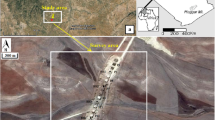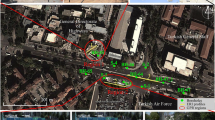Abstract
This study presents an approach of information on ground-penetrating radar (GPR), DC resistivity, and hydrogeochemical data for monitoring the potential of fresh groundwater zone, both quantitatively and qualitatively. This is applied in new urban area located at the coast of the Red Sea. First, a GPR survey is conducted to provide the preliminary data on the lithology, subsurface structure, and accumulation of groundwater in the aquifer. Then, a DC resistivity enabled the mapping of several geoelectric layers with info, water table, depth, and thickness of each water-bearing layer. Vertical electrical sounding is acquired and calibrated using available data of observation boreholes as well as the near GPR profiles to verify the results. In addition, water samples from drilled wells and springe are collected to evaluate hydrogeochemical characteristic and hydrogeological setting of the aquifers. Geophysical and hydrogeological datasets indicated the presence of two aquifers; the first aquifer occupies the zone of wadi deposits, and the second aquifer occurs in the fractured basement rock. The salinity in these aquifers shows heterogeneous distribution, but generally increases with depth, and is basically dependent to the prevailing structural framework and geological conditions. Such data integration shows the potential of the proposed approach in exploring and evaluating groundwater resources in semi-arid coastal plains using hydrogeological, DC resistivity, and GPR data.










Similar content being viewed by others
References
Abdel Moneim AA (2005) Overview of the geomorphological and hydrogeological characteristics of the Eastern Desert of Egypt. Hydrogeol J 13:416–425
Abdelkareem M, El-Baz F (2015) Analyses of optical images and radar data reveal structural features and predict groundwater accumulations in the central Eastern Desert of Egypt. Geoscience 8:2653–2666
Ageeb GW, Kotb MM, Rahim IS (2007) Soil mapping of Wadi Hodein Area, Southeastern Egypt using remote sensing and GIS techniques. Aust J Basic Appl Sci 1(4):793–800
Annan A (2006) GPR methods for hydrogeological studies. Hydro geophysics 50:185–213
Attwa M, Henaish A, Zamzam S (2020) Detection and prediction of geo-environmental hazards in urban areas and desert lands using an integrated structural and geophysical approach: cases from Egypt. In: Waste Management in MENA Regions. Springer, Cham, pp 71–92
Bobachev AA (2008) IPI2 Win software. http://geophys.geol.msu.ru
Barsom N (2016) Remote sensing and groundwater data investigation in plain west of Nile, Qena Governorate, Egypt. In: Bhattacharya B, Shalivahan S (eds) Geoelectric Methods: Theory and Applications. McGraw Hill Education, New Delhi, India, p 147
Dahlin T (2001) The development of. DC resistivity imaging techniques: computers & geosciences 27:1019–1029
Dauda M, Habib GA (2015) Graphical techniques of presentation of hydro-chemical data. J Environ Earth Sci 5 no. 4
Dentith M, O’Neill A, Clark D (2010) Ground penetrating radar as a means of studying palaeofault scarps in a deeply weathered terrain, southwestern Western Australia. J Appl Geophys 72:92–101
EGSMA (2002) Geological map of Halayeb-Abu Ramad area Egypt, with scale 1:100,000.
El-Bayoumi RMA, Greiling RO (1984) Tectonic evolution of a Pan-African plate margin in Southeastern Egypt – a suture zone over printed by low angle thrusting. In: Michot J (ed) Klerkx, J. African Geology, Tervuren, pp 47–56
Gaber A, Mohamed AK, ElGalladi A, Abdelkareem M, Beshr AM, Koch M (2020) Mapping the groundwater potentiality of West Qena Area, Egypt, using integrated remote sensing and hydro-geophysical techniques. Journal of Remote Sensing 12:1559. https://doi.org/10.3390/rs12101559
Hughes LJ (2009) Mapping contaminant-transport structures in karst bedrock with ground-penetrating radar. Geophysics 74(6):B197–B208
Huisman JA, Sperl C, Bouten W, Verstraten JM (2001) Soil water content measurements at different scales: accuracy of time domain reflectometry and ground-penetrating radar. J Hydrol 245:48–58
IPI 2WIN Program; Version 3.1 2C; 17.10.08, 2008: Bobachev, Programs Set. Dep. Of Geophysics, Geological Faculty, Moscow University, Russia, 119899.
Jeffrey E, Patterson FA, Cook (2002) Successful application of ground penetrating radar in the exploration of gem tourmaline pegmatites of Southern California. Geophys Prospect 50(2):107–117. https://doi.org/10.1046/j.1365-2478.2002.00312.x
JOL HM (ed) (2009) Ground penetrating radar theory and applications. Elsevier, Amsterdam, 524p
Khalil MH (2014) Detection of magnetically susceptible dyke swarms in a fresh coastal aquifer. Pure Appl Geophys 171:1829–1845 Springer Basel
Loke MH, Dahlin T (2002) A comparison of the Gauss-Newton and quasi-Newton methods in resistivity imaging inversion. J Appl Geophys 49:149–162
Maheswari K, Kumar PS, Mysaiah D, Ratnamala K, Rao MSH, Seshunarayana T (2013) Ground penetrating radar for groundwater exploration in granitic terrains: a case study from Hyderabad. J Geol Soc India 81(June 2013):781–790
Mahmoud H, Tawfik MZ (2015) Impact of the geologic setting on the groundwater using geoelectrical sounding in the area southwest of Sohag–Upper Egypt. J Afr Earth Sci 104:6–18
Mangue M (2005) Non-destructive geophysical monitoring of near-surface water-content: comparison between GPR velocities obtained from surface and well experiments. AGU fall Meetings, San Francisco, CA, USA
Meneisy AM (2020) Impact of subsurface structures on groundwater exploration using aeromagnetic and geoelectrical data: a case study at Aswan City, Egypt. Arab J Geosci 13:1213. https://doi.org/10.1007/s12517-020-06201-0
Nano L, Kontny A, Sadek MF, Greiling RO (2002) Structural evolution of metavolcanics in the surrounding of the gold mineralization at El Beida, South Eastern Desert, Egypt. Ann Geol Surv Egypt XXV:11–22
Onishi K, Yokota T, Maekawa S, Toshioka T, Rokugawa S (2005) Highly efficient CMP surveying with ground penetrating radar utilising real-time kinematic GPS. Explor Geophys 36:59–66
Reynolds JM (2011) An introduction to applied and environmental geophysics, 2nd edn. John Wiley and Sons Ltd., pp 289–345
Rosemary K (2001) Ground penetrating radar for environmental applications. Annu Rev Earth Planet Sci 29:229–255
Sandmeier KJ (2001) Program for processing and interpretation of reflection and transmission data, D-76227 Karlsruha, Germany. Guide and Manual of the processing program REFLEX
Sonkamble S, Satishkumar V, Amarender B, Sethurama S (2013) Combined ground-penetrating radar (GPR) and electrical resistivity applications exploring groundwater potential zones in granitic terrain. Arab J Geosci 7:3109–3117. https://doi.org/10.1007/s12517-013-0998-y
World Health Organization (2011). Guidelines for drinking-water quality, 4th ed. World Health Organization. https://apps.who.int/iris/handle/10665/44584
Yousef AF, Salem AA, Baraka AM, Aglan OS (2009) The impact of geological setting on the groundwater occurrences in some Wadis in Shalatein – Abu Ramad Area, South Eastern Desert, Egypt. Eur Water Pub (EWRA) 25(26):53–68
Yuji T, Kobayashi H, Tao K, Kayhotsu I (2004) Measurements of groundwater behavior in sandy soils using surface ground penetrating radar. In: Proceeding of 10th International Conference on Ground Penetrating Radar, 221-24 June, 2004, Delft, The Netherlands, pp 517–520
Acknowledgements
The authors would like to appreciate the Research Institute for Groundwater (RIGW) and National Water Research Center (NWRC) for their support in achieving this work and for providing the equipment and instruments to acquire the data and make the resources available to analyze acquired data and interpret the results. Also, we are grateful to the reviewers who spent hours/days of their personal time on our manuscript to make it suitable for publication.
Author information
Authors and Affiliations
Corresponding author
Ethics declarations
Conflict of interest
The authors declare that they have no competing interests.
Additional information
Responsible Editor: Zakaria Hamimi
This article is part of the Topical Collection on Advances of Geophysical and Geological Prospection for Natural Resources in Egypt and the Middle East
Rights and permissions
About this article
Cite this article
Bedair, S., Abdel-Raouf, O. & Meneisy, A.M. Combined GPR, DC resistivity, and hydrogeochemical data for hydrogeological exploration: a case study at the Red Sea coast. Arab J Geosci 14, 727 (2021). https://doi.org/10.1007/s12517-021-07039-w
Received:
Accepted:
Published:
DOI: https://doi.org/10.1007/s12517-021-07039-w




